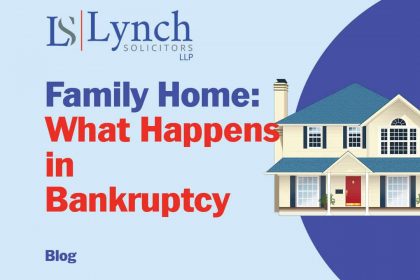
What happens to the family home in bankruptcy? This is a very emotive issue and one that we are frequently asked when dealing with bankruptcy issues. This blog looks at the issue and answers the most commonly asked questions.
In Bankruptcy your Lender will invariably keep the family home out of bankruptcy.
This means that the lender proves their debt, the bankrupt’s interest vests in the official assignee, the lender retains control of the asset, and the Assignee does nothing where the home remains in negative equity.
Where the home continues to be in negative equity, the official assignee will allow the bankrupt’s interest to be released back after three years.
In the meanwhile, the assignee in bankruptcy will do nothing and will not object to the lender selling the home [as mortgagee in possession]. Selling as mortgagee in possession means that the lender can do all the required legal formalities to sell the home. The assignee however takes no active part in the process of sale.
The matter can be complicated if the property is held jointly with a spouse or partner.
Video: What happens to the family home in personal insolvency or bankruptcy?
John Lynch looks at the differences in how the family home is handled in this video.
Lynch Solicitors for Information Purposes Only
Matters can be further complicated if there is equity during the three-year period the property remains vested in the Assignee. In such circumstances, the assignee in bankruptcy is entitled to apply to the court for an order for sale.
There have been situations where the lender has proven their debt but has not in fact gone on to sell the family home even though it’s in negative equity. In such circumstances, the bankrupt has two choices.
- He or she can vacate the family home which has the effect of writing off any residual debt over the value of the security. This is in effect a voluntary surrender.
- They can, with the consent of the bank, remain in the property on the basis of a revised are reviewable payment arrangement. If, however, they remain in the property they will have to come to an agreement with the Bank on repayments.
This raises the interesting scenario that if the discharge bankrupt subsequently vacates the family home whether the lender would be entitled to pursue the balance in circumstances where such a balance had been written off through the bankruptcy process.
Where the family home as a negative equity there have been a number of initiatives – the buy to let scheme – to try and keep people in their homes.
If someone is considering bankruptcy and is in discussions with their lender to put a buy to let the proposal in place, they should ensure that the lender is prepared to continue with the buy to let the proposal in the event of an application for bankruptcy.
Where the house is in negative equity, a buy to let the proposal gives the lender the value of the security. The lender/owner then transfers the house to the local authority or other agency who purchases the house from them. That agency in turn enters into a letting agreement with the debtor. If the debtor becomes bankrupt, the official assignee will not object to the lender selling to the local authority or other agency [as mortgagee in possession].
It is therefore critically important to investigate the likely outcome of bankruptcy where the family home is involved and where the bankrupt may wish to retain the family home.
Contact Us
We have a dedicated practice area for issues related to bankruptcy. Our experts can guide you through the process and discuss the options that are open to you. Call us on 052 6124344 or email: reception@lynchsolicitors.ie to arrange a meeting.
Find Out More About Bankruptcy & Insolvency
Our Bankruptcy & Insolvency Services
At Lynch Solicitors, we are one of the few solicitor firms who specialise in dealing with Bankruptcy & Personal Insolvency. We offer a one-stop service in an area that has undergone tremendous change in recent times, most notably, the introduction of one-year bankruptcy. We have appeared for clients in the High Court Bankruptcy Court. We appreciate that the decision to enter bankruptcy is not an easy one to make. We understand that the decision has many aspects that need consideration. We are happy to give clients the benefit of our experience in this relatively new and developing area of law. Read more here.
Bankruptcy in Ireland – A Quick Guide
The issue of bankruptcy in Ireland is one mired in much confusion. While the issue has been covered at length in recent years by the media, there is still a misunderstanding of what bankruptcy is and what happens to a person that becomes bankrupt. This brief looks at the issue and answers the most commonly asked questions. Read more here.
One Year Bankruptcy
One year bankruptcy is now a reality in Ireland after the Bankruptcy (Amendment) Act 2015 was brought into law by a commencement order on Friday, January 29th, 2016.
The commencement order reduced the normal duration of bankruptcy from three years to one-year bankruptcy. Read more here.
Video: The Difference Between Insolvency & Bankruptcy
Lynch Solicitors for Information Purposes Only


Thanks for sharing this great information regarding family bankeupty Issue. It’s very useful we also provides Family business service in Ireland. Superlative Blog!!!
Thank you for taking the time to comment on our post.